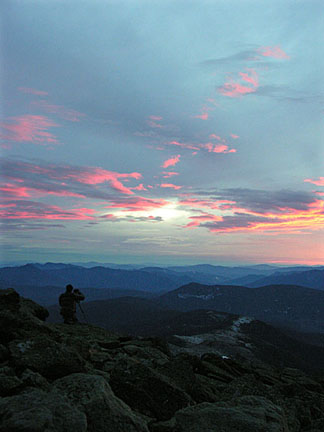While waiting for the sunset in the southern Ossipees yesterday, I began thinking of all of the things I've learned over the years from sunset hiking. When the clocks are changed, my after work hiking possibilities suddenly limited to sunset hikes, so I generally do 20-30 or so a year. While I have learned a lot from that experience, perhaps the biggest thing I've learned is that I still have a lot to learn!
Anyways, I thought I'd get this started with some things I've concluded/hypothesized:
- Pre-hike your route. It's important to know the trail in daylight, so that a) you know how much time it takes to get up it, b) you know the terrain for descending in the dark, and c) you know there is a westerly view for the actual sunset.
- If you can, watch the radar and satellite imagery before you depart. Sometimes you can detect a thick band of junk closing in from the west (thus dramatically minimizing the chances of seeing any color), while other times, on the poorest of afternoons, you may be able to detect a lessening of clouds to the west.
- Clear days tend to result in mediocre sunsets (less particles in the air, no clouds to illuminate), while particularly cloudy days can result in the best sunsets (or absolute duds).
- Let someone know where you're going, and do not stray from that route.
- Bring two headlamps, in case the first dies on you.
- Always be prepared to be colder than you think it'll be. Even in the summer, the winds from the west can cool things down big time. Since you'll be standing still to watch the event, you'll be cooling down rather quickly.
- Take lots of photos, from different zooms and different settings (this is a generic point and shoot camera statement). I've found that sometimes my best photos were ones that I thought were mediocre while I took them, while the ones I thought would be the best ended up being poor.
- When you figure the best colors have passed and it's time to go, stay. I've often made this conclusion, only to see a more vivid display suddenly occur once I reached the trees.
- As an addition to the previous item, if you have any inclination unrelated to patience (ie you're getting cold, etc.), don't stay, get going! The risk factor is extremely elevated at night.
- If there's an eastern viewpoint, check it out on occasion - sometimes the best colors will be behind you.
Those are some of the things I can think of offhand. I'm most certainly an amatuer, however, so perhaps some of the pros can chime in and give us their expert tips!
Anyways, I thought I'd get this started with some things I've concluded/hypothesized:
- Pre-hike your route. It's important to know the trail in daylight, so that a) you know how much time it takes to get up it, b) you know the terrain for descending in the dark, and c) you know there is a westerly view for the actual sunset.
- If you can, watch the radar and satellite imagery before you depart. Sometimes you can detect a thick band of junk closing in from the west (thus dramatically minimizing the chances of seeing any color), while other times, on the poorest of afternoons, you may be able to detect a lessening of clouds to the west.
- Clear days tend to result in mediocre sunsets (less particles in the air, no clouds to illuminate), while particularly cloudy days can result in the best sunsets (or absolute duds).
- Let someone know where you're going, and do not stray from that route.
- Bring two headlamps, in case the first dies on you.
- Always be prepared to be colder than you think it'll be. Even in the summer, the winds from the west can cool things down big time. Since you'll be standing still to watch the event, you'll be cooling down rather quickly.
- Take lots of photos, from different zooms and different settings (this is a generic point and shoot camera statement). I've found that sometimes my best photos were ones that I thought were mediocre while I took them, while the ones I thought would be the best ended up being poor.
- When you figure the best colors have passed and it's time to go, stay. I've often made this conclusion, only to see a more vivid display suddenly occur once I reached the trees.
- As an addition to the previous item, if you have any inclination unrelated to patience (ie you're getting cold, etc.), don't stay, get going! The risk factor is extremely elevated at night.
- If there's an eastern viewpoint, check it out on occasion - sometimes the best colors will be behind you.
Those are some of the things I can think of offhand. I'm most certainly an amatuer, however, so perhaps some of the pros can chime in and give us their expert tips!











